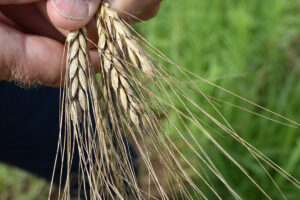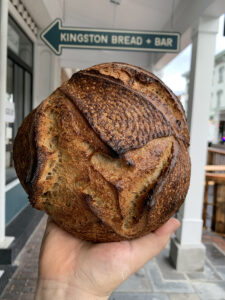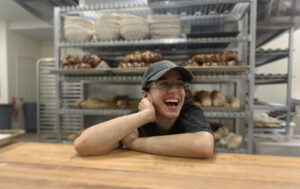BAKERIES AND HOME BAKERS TEST VARIETIES OF GRAINS TO EXPAND LOCAL GRAINS ECONOMY
By Sarah Brannen
Sarah Brannen is the Associate Director of Programs

The Hudson Valley may be known for apples, cider, and fall pumpkin picking, but grains are beginning to receive their due attention. In recent years small grains, such as wheat and rye, have become a newfound focus for local chefs and bakers. There is also a resurgence of home baking. During the peak of the COVID pandemic earlier this spring, shoppers cleared stores out of flour and yeast and took to social media to share photos and stories about baking their way through lockdown and taking comfort in the simple pleasure of a handmade pie or tray of cookies or no-knead bread.
Grains have been a staple food since humans walked the earth. Corn has a 10,000-year history, starting with the first domesticated plants in what is now Oaxaca, Mexico. Similarly, domesticated wheat can be traced back to 12,000 years ago. Today, grains continue to be the largest portion of the human diet worldwide. Yet despite their importance to our history and diets and the renewed interest in grains, the amount of local grains available for local consumption remains very small.
The combined interest in grains and resurgence in baking feeds into the Farm Hub’s continued work in expanding the local grains economy.

The Farm Hub has been engaged in an effort to revive grains in the Hudson Valley for the past seven years. We began our journey in 2014 with the small grains variety trial, in partnership with Cornell University and Cornell Cooperative Extension, Ulster County.
Since then, we have tested more than 100 types of wheat, barley, rye, oats, and more recently ancient grains to identify which are the most adapted to our climate.
We’ve hosted field days at the farm, coordinated milling and baking trials, and held an event in 2018 to share our lessons learned with the food and farming community. This year, we’ve expanded this work to include more baking trials to test out locally milled flour, made from wheat grown at the Farm Hub.

The culinary benefits of small grains are supplemental to their critical contributions to building sustainable agricultural practices. Not only do they provide biological diversity in crop rotation, they also produce a bi-product –straw, used for mulching crops (e.g. garlic) – and serve as an effective soil cover, both in preventing soil erosion from winds or rain and in retaining soil moisture and soil organic matter in drought-like conditions, which have become increasingly prevalent in the last few years of demonstrated climate change. Growing the local grain economy means building resilience into our existing agriculture and food systems through diversification and adaptation, something which bakers within the region are starting to see and appreciate on many levels.
The baking trials underway since 2020 have included a number of local bakeries, including Agnes Devereaux, Bread Alone, Katie Rose, Kelly’s, Kingston Bread + Bar, Our Daily Bread, Outdated Café, Sparrowbush, and Tortilleria Nixtamal based in New York City, as well as a number of our Farm Hub coworkers who are baking at home.
“I love using locally grown grains for their freshness, their flavor and the knowledge that I’m supporting local farmers,”
–Agnes Devereax, owner of a catering business.

The aspiration for these baking trials is to receive feedback about the flour’s quality, such as water absorption, rise, and oven spring (how much the loaf rises when baked). Additionally, we are receiving feedback about the flavor and texture of the bread baked with the flour.
The bread flour shared with the bakers is a blend of Tom wheat (a hard red spring variety) and Medina wheat (a soft white winter variety) that has been sifted to approximately 73 percent whole wheat content. It also has a higher protein content that makes it well suited to baking a hearty, crusty loaf of bread.
So far, the feedback from the bakers has been educational and promising.
Kevin Halim at Kelly’s Bakery in Poughkeepsie, Katie Vanzandt at Katie Rose Bakery in Hopewell, and one of our home bakers reported that our flour is “thirsty” meaning it absorbs a lot of water. That makes for a stickier dough and requires differing handling with which some bakers might not yet be accustomed.

We learned that the bread baked with the flour has a beautiful color, nice crust, and a dense, chewy crumb, as seen in the bread baked by Aaron Quint of Kingston Bread + Bar and Kevin Halim of Kelly’s Bakery. The bakers reported that the flavor was quite good too.
“Farming in an ever-changing climate while also preserving and breeding better tasting wheat varietals is a huge challenge. With the recent setbacks due to COVID-19 all over the world, more support is needed to keep the local grain movement moving forward,”
– Kevin Halim, owner of Kelly’s Bakery.
Katie Vanzandt of Katie Rose bakery said that she “had a great time playing around with the flour” and that it had a nice, soft texture with great flavor. Vanzandt incorporated the flour into her whole grain bread, along with local apples, honey, oats, and cranberries and found it came out dense and flavorful.
I can report that my at-home experimentation with pizza dough made from this bread flour was an adventure. It rose well and made a pizza with a satisfyingly crispy crust. While my novice pizza tossing and shaping skills did not do this dough justice, the flavor was excellent.

In the coming weeks, we’ll be hearing more about the products baked with this flour, including flour tortillas from Tortilleria Nixtamal, which until now has typically focused on corn-based tortillas. We’re already receiving requests for more flour and hope that one day soon there will be Hudson Valley flours widely available.
“Using local flours from the Hudson Valley would put even more love and flavor into my bread, which I would love to share with the community,” said Vanzandt of Katie Rose Bakery.
To view our short documentary “Growing With the Grain” on our small grains research click here.
Lead Photo: Sharon Burns, right, owner of Bread Alone Bakery takes part in baking trials using flour from the Farm Hub. Photo by Allison Usavage, courtesy of Cornell University.
